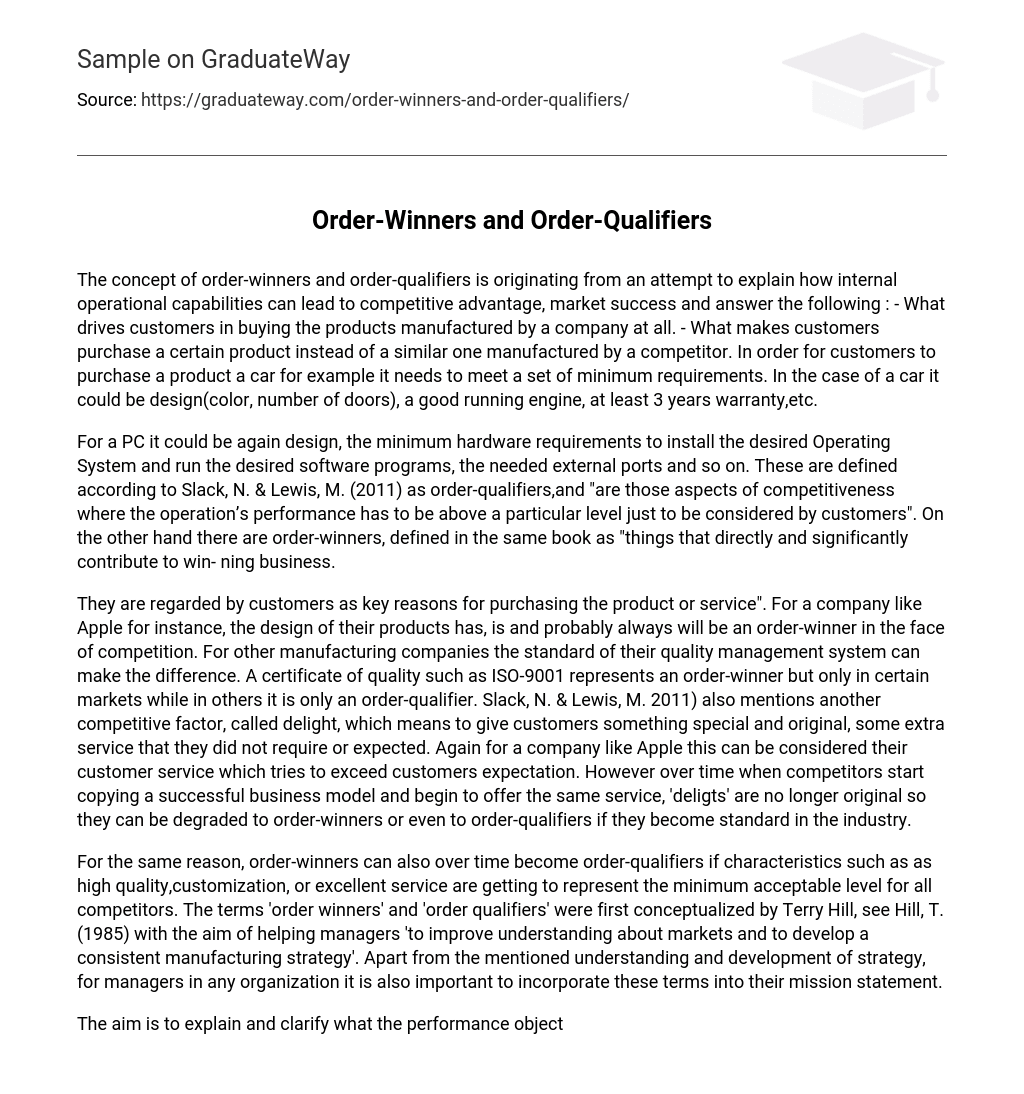The concept of order-winners and order-qualifiers is originating from an attempt to explain how internal operational capabilities can lead to competitive advantage, market success and answer the following : – What drives customers in buying the products manufactured by a company at all. – What makes customers purchase a certain product instead of a similar one manufactured by a competitor. In order for customers to purchase a product a car for example it needs to meet a set of minimum requirements. In the case of a car it could be design(color, number of doors), a good running engine, at least 3 years warranty,etc.
For a PC it could be again design, the minimum hardware requirements to install the desired Operating System and run the desired software programs, the needed external ports and so on. These are defined according to Slack, N. & Lewis, M. (2011) as order-qualifiers,and “are those aspects of competitiveness where the operation’s performance has to be above a particular level just to be considered by customers”. On the other hand there are order-winners, defined in the same book as “things that directly and significantly contribute to win- ning business.
They are regarded by customers as key reasons for purchasing the product or service”. For a company like Apple for instance, the design of their products has, is and probably always will be an order-winner in the face of competition. For other manufacturing companies the standard of their quality management system can make the difference. A certificate of quality such as ISO-9001 represents an order-winner but only in certain markets while in others it is only an order-qualifier. Slack, N. & Lewis, M. 2011) also mentions another competitive factor, called delight, which means to give customers something special and original, some extra service that they did not require or expected. Again for a company like Apple this can be considered their customer service which tries to exceed customers expectation. However over time when competitors start copying a successful business model and begin to offer the same service, ‘deligts’ are no longer original so they can be degraded to order-winners or even to order-qualifiers if they become standard in the industry.
For the same reason, order-winners can also over time become order-qualifiers if characteristics such as as high quality,customization, or excellent service are getting to represent the minimum acceptable level for all competitors. The terms ‘order winners’ and ‘order qualifiers’ were first conceptualized by Terry Hill, see Hill, T. (1985) with the aim of helping managers ‘to improve understanding about markets and to develop a consistent manufacturing strategy’. Apart from the mentioned understanding and development of strategy, for managers in any organization it is also important to incorporate these terms into their mission statement.
The aim is to explain and clarify what the performance objectives are, and to focus everyones efforts in accomplishing these objectives. It has to be mentioned that despite of their popularity, these concepts have also been the target of some criticism. First of all because the order-winners concept is bound to a short-term perspective of a marketplace. In practice, for strategic reasons long-term relationsships will exists between purchasers or suppliers despite of a temporary diminishing quality of certain order-winners and order-qualifiers.
Secondly because the concept was based merely on individual customers for individual orders instead of considering larger groups of customers(Slack, N. & Lewis, M. (2011)). References: Hill, T. (1985). Manufacturing Strategy: The Strategic Management of the Manufacturing Function, first ed. Macmillan, Basingstoke; Hill, T. , 2000. Manufacturing Strategy: Text and Cases, second ed. Palgrave, Basingstoke Slack, N. & Lewis, M. (2011) Operations strategy. 3rd ed. Harlow: Financial Times and Prentice-Hall





